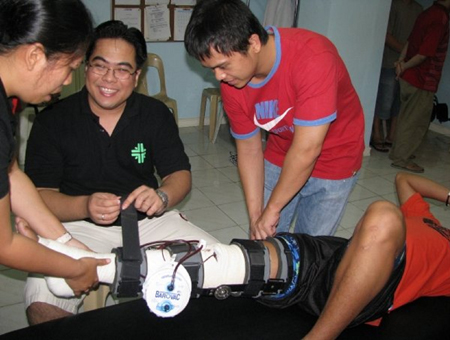What is Multiple Sclerosis (MS)?
Multiple Sclerosis (or MS for short) is believed to be a chronic autoimmune disease that attacks the central nervous system (CNS). The central nervous system consists of the brain, optic nerves, and all the nerves in the spinal cord. In order for these nerves to properly transfer the electrical signals to and from the brain that allow us to move our muscles or feel pain, these nerves are coated with a substance called “Myelin” which build the “Myelin Sheath”. The myelin sheath is a natural insulator made up of proteins and phospholipids, a type of fatty acid. It is believed that in MS, the body’s immune system (which is supposed to help fight off foreign substances like viruses so we don’t get sick) malfunctions and starts attacking this myelin coating around the nerves and maybe even “oligodendrocyte” cells which are what produce the myelin in our bodies.
Sound complicated? Let’s make this a little simpler. In this day and age we all have electronic devices that plug into the wall, they run on electricity, we all know that right? Our bodies run on electricity as well, so think of it like this; A light switch leads to a copper wire, which leads to a light bulb. When we want to turn the light bulb on we flip the light switch and electricity is sent from the switch to the light bulb via the wire making the bulb turn on. Our brain is like the light switch, our nerves are like the copper wire, and our muscles are like the light bulb. If we want to turn our muscles on, we “flip the switch” in our brain which sends an electrical signal across our nerves (the wire) to turn that muscle on (the light bulb).
Now, let’s apply Multiple Sclerosis to this analogy; If you stripped the rubber insulation off the copper wire would your light bulb work properly? Probably not, well, not safely at least! So in our analogy the wire represents our nerves but our nerves are not just one solid piece of material just as the copper wire in our light bulb analogy is not just a solid piece of copper. There are multiple parts to both our nerves and electrical wires. With nerves, you have the actual nerve fiber itself which is covered in the insulating myelin sheath much like our light bulb’s copper wire is covered in an insulating rubber sheath. So just like the light bulb won’t work properly after it’s wire’s rubber sheath has been stripped away, your muscles won’t work properly after it’s nerve’s myelin sheath has been stripped away.
Nerves control everything in your body from lifting your arm, feeling a cool breeze against your skin, knowing if and object is hot or cold, to feeling that you stubbed your toe. Even things like maintaining your balance or using the restroom require the proper functioning of nerves! So if the myelin in your central nervous system is damaged, that would render yours nerves incapable of functioning properly and this of course means that various parts of your body may malfunction. Maybe you can’t move a leg as well, you go numb in certain areas, or you loose you balance easily! There are many, many symptoms of MS and not everyone experiences them all. It all depends on where the myelin has been damaged, where the “rubber insulation” is missing along your wire.
Rehabilitation of MS
Rehabilitation is an important part of health care delivery for persons with multiple sclerosis.
Since the majority of people are diagnosed between the ages of 20 and 50, the challenges of
MS affect those at the peak of their career and childrearing years. Although MS can affect children and teens, it is much less common in this age group. Rehabilitation team members need information, experience, and sensitivity relating to the variability of symptoms between individuals, and to the unpredictable and fluctuating nature of this challenging, generally progressive disease. Unlike most other neurological disorders, including spinal cord injury, traumatic brain injury, and stroke, there is no “fixed deficit” in MS; symptom profile, lesion burden on MRI, and disease course vary over time. Therapists must be prepared to treat each MS patient individually, and with flexibility, over the long term. In the treatment of people with MS, there are no protocols or time limits—just a unique opportunity to employ numerous problem solving skills, interventions, and resources. And because MS affects not just an individual, but a whole family, it is a disease that benefits from a team approach— making coordination and communication with other health care providers extremely important.
The Ongoing Role of Physical Therapy in MS
The role of physical therapy will vary across the disease course. In general, however, interventions should focus on helping the patient to achieve and maintain optimal functional independence, safety, and quality of life, with the understanding that needs will vary and likely grow over time. In all care delivery models—inpatient (acute, transitional, rehabilitation or long-term care), outpatient, or home care—physical therapists (PTs) must:
- Be prepared to educate patients and their care partners about the critical role of rehabilitation, provide training in specific strategies, and provide resources for equipment and accessible, appropriate community programs.
- Be ready to assist with case-management and provide emotional support.
It’s very helpful to work with a physical therapist if you have MS. At Rehab Experts, you will learn the safest ways to exercise for your symptoms and condition.
The first visit includes an evaluation and exercises for you to do at home. These moves address the physical symptoms of MS.
Our therapist will also create a special fitness program for your unique strengths and goals. Regular exercise helps people with all types of MS and at all different levels of ability. You’ll learn how to work around fatigue and heat sensitivity to get the full benefits of exercise.
Our physical therapist may show you better ways to move or do household tasks. Follow-up visits check on your progress as well as review and expand your home program. You may learn:
- Stretches to prevent or ease spastic muscles
- Moves to keep muscles strong
- Range-of-motion exercises
- Gait training for easier walking
- How to use canes, crutches, scooters, wheelchairs, or other aids
Our company can provide more physical therapy sessions to help you reach your goals, like overcoming a foot drag that slows your pace.
Rehab Experts Physical Therapy Home Programs
Our key components of a successful home program are that it is enjoyable, varied, goal-oriented
and realistic. Compliance issues include fatigue, poor motivation, depression, lack of needed
support or assistance from family and friends, time constraints, and cognitive dysfunction (usually short-term memory, attention, or sequencing deficits, which requires the therapist to provide the exercises in written instructions and pictures). Emphasis needs to be placed on corrective exercises to:
(1) improve function (restoring alignment, mobility, and strength/endurance lost due to inactivity/disuse or compensatory movement patterns),
(2) manage spasticity (slow stretching, cold packs, controlled position changes), and
(3) control energy management (careful pacing, flexible Physical Therapy in Multiple Sclerosis Rehabilitation
With the advent of disease modifying agents to prolong time between attacks and slow disease progression, Physical Rehab interventions are more important and more cost-effective than ever before. Interventions have the potential to last longer and have greater impact on improving quality of life.
References:
- Matt Ms http://www.mattsms.com/2013/07/about-ms-what-is-multiple-sclerosis.html
- National MS Society
- Remedy’s Health Communities http://www.healthcommunities.com/multiple-sclerosis/ms-exercise-physical-therapy_bht.shtml
- WebMD http://www.webmd.com/multiple-sclerosis/guide/multiple-sclerosis-physical-therapy

